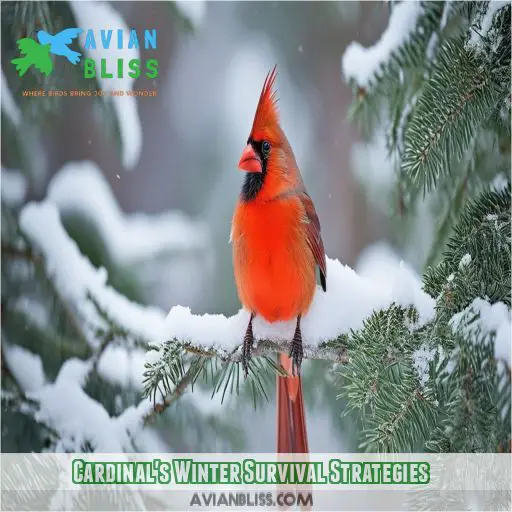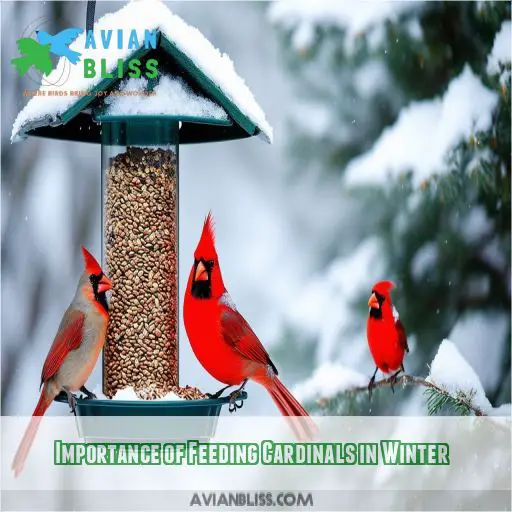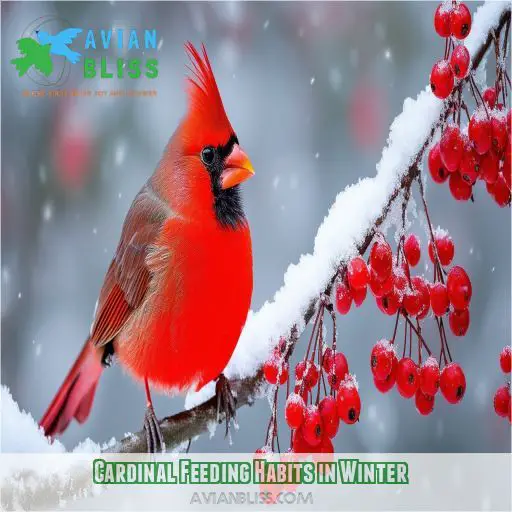This site is supported by our readers. We may earn a commission, at no cost to you, if you purchase through links.

Inside, you will learn precisely their remarkable adaptations of feeding and behavioral patterns to ensure survival when times get hard and food is scarce. Learn why offering cardinal food in winter is crucial and what you can do to make your yard friendly and inviting to these winged buddies.
Unravel mysteries of their startling winter plumes and social dynamics. Knowing what cardinals do in the winter will make you appreciate these hardy creatures and nature’s ingenious adaptations even more.
Table Of Contents
- Key Takeaways
- What Do Cardinals Do in the Winter?
- Cardinal’s Winter Survival Strategies
- Importance of Feeding Cardinals in Winter
- Cardinal Feeding Habits in Winter
- Creating Cardinal-Friendly Feeding Environment
- Frequently Asked Questions (FAQs)
- How do cardinals survive cold winters?
- Should you feed cardinals in winter?
- Where do cardinals sleep in winter?
- Is it normal to see cardinals in the winter?
- Do cardinals change color during winter months?
- How do cardinals stay warm at night?
- Do cardinals migrate short distances in harsh winters?
- Can cardinals recognize human faces at winter feeders?
- Do cardinals form winter flocks with other species?
- Conclusion
Key Takeaways
- Cardinals are tough little cookies who don’t fly south for the winter. Instead, they hunker down and face the cold head-on, using clever tricks like huddling together for warmth and foraging for seeds and berries. Talk about staying power!
- These red-feathered friends become regulars at backyard feeders during the chilly months. Offering them a smorgasbord of sunflower seeds, safflower seeds, and suet is like giving them a warm winter coat – it helps them keep their engines running when the mercury drops.
- Winter doesn’t put a damper on cardinals’ social lives. They’ll often hang out in small flocks, turning your yard into a bustling bird cafe. It’s like they’re having their own little winter block party!
- Cardinals are nature’s pop of color in a monochrome winter landscape. Their vibrant plumage isn’t just for show – it helps them blend in with winter berries and foliage. Who knew camouflage could be so eye-catching?
What Do Cardinals Do in the Winter?
In winter, cardinals adapt to survive harsh conditions. You’ll see these hardy birds huddling together for warmth and foraging for seeds and berries. They rise early to maximize daylight hours and adjust their feathers for better camouflage.
Cardinals communicate with chip notes to stay in touch with their flock. They’ll frequent bird feeders, consuming sunflower seeds, safflower seeds, and cracked corn to meet their increased nutritional needs. At night, they seek shelter in dense evergreen trees or thick shrubs.
Unlike some birds, cardinals don’t migrate or change color during winter. Their resilience and adaptability make them a year-round favorite for bird enthusiasts.
Discover more about these remarkable winter survivors below.
Cardinal’s Winter Survival Strategies
As winter’s chill approaches, cardinals don’t pack their bags and fly south; such hardy birds tough it out with clever strategies to survive the cold months.
You’ll often spot them foraging on ground level, searching for seeds and berries that comprise their diet during the winter season. They aren’t fussy eaters; they switch up their menu according to the season.
Cardinals huddle together for warmth, especially when the weather is harsh. Their feathers are colored not just to be beautiful but also to blend with winter berries and foliage.
If you listen, you might catch the chip notes of these birds when they communicate with each other. Cardinals don’t migrate for the winter but remain in their territories all year round, and often a pair will stay together throughout the season.
They rise early to take full advantage of daylight hours in search of food. These birds are so adaptable that they’ve learned to survive through most winters—such is the resiliency of nature.
Importance of Feeding Cardinals in Winter
If you do, then you may generally be asking yourself why it’s important to feed cardinals when winter arrives. These birds used to have a very hectic season due to the fact that they use much energy in the search for food and keeping warm. Unlike some animals, cardinals are unable to store foods in their bodies; thus, they depend on daily intake of food for survival. That’s where you’ll come in. Providing them with a dependable source of food means much more than just offering them a daily meal; you actually save them.
Cardinals need additional calories during the winter to keep their bodies warm and metabolisms revving. If that’s not enough, they won’t survive cold months without adequate food. Your effort at feeding will help keep them hardy, safe, healthy, and secure in your yard. You’ll also be rewarded with the sight of their brilliant winter plumage and the audio of female vocalizations as they come to your feeders. That way, you both win: you and your feathered friends.
Cardinal Feeding Habits in Winter
With winter, cardinals’ eating behavior changes as their nutritional requirements increase. You’ll find these birds more at feeders since they adjust their behaviors to get through tough times. Note that most of them are normally the first to come and the last to leave, hence spending maximum time at feeders.
Cardinals are primarily seed eaters, although they consume insects and fruits where possible. The powerful beaks of the birds can crack open tough shells, and one of their very favorite winter treats is sunflower seeds.
At this time of year, you might see cardinals foraging in small flocks; during other months, they usually stay in pairs or individually. This behavior during that period of the year helps them search for food and avoid predators under such harsh winter conditions.
What’s more interesting, though, is the fact that these cardinals contribute to the survival of other species by participating in seed dispersal during the coldest months of the year.
Creating Cardinal-Friendly Feeding Environment
Of course, making a feeding area suitable for the cardinals would require considering their preferences and habits. These birds like everything planned out, and so below is how you can make your yard a haven for Cardinals:
- Varied Food: Sunflower seeds, safflower seeds, cracked corn, and dried berries on platform feeders.
- Suet cakes: These high-energy food sources come in most handy during the cold winter months.
- Provide adequate nest protection: Establish dense shrubs or trees close to feeding areas, providing them with shelter and potential nesting sites.
- Sanitation: Clean equipment used in feeding on a regular basis to avoid the spread of diseases, and maintain general cleanliness around the feeding area.
Frequently Asked Questions (FAQs)
How do cardinals survive cold winters?
Ever wonder how these vibrant birds brave the chill? Cardinals huddle together, fluff their feathers for insulation, and seek shelter in dense foliage. They’ll visit your feeder for high-energy seeds, storing fat to keep warm through long winter nights.
Should you feed cardinals in winter?
Yes, you should feed cardinals in winter. They’ll appreciate the extra calories for warmth and energy. Offer black-oil sunflower seeds, safflower seeds, and suet in platform feeders. Consistent feeding helps these beautiful birds thrive during harsh months.
Where do cardinals sleep in winter?
In winter, you’ll find cardinals nestled in dense evergreen trees or thick shrubs. They’ll huddle together for warmth, often in small groups. These cozy spots shield them from harsh winds and predators, ensuring a safe night’s rest.
Is it normal to see cardinals in the winter?
You’ll be blown away by the winter cardinal spectacle! It’s absolutely normal to spot these vibrant red visitors year-round. They’re tough cookies, sticking around through snow and ice, brightening up your backyard with their cheerful presence.
Do cardinals change color during winter months?
No, cardinals don’t change color in winter. You’ll see males keeping their bright red plumage year-round, while females maintain their brownish-red feathers. Their vibrant appearance actually stands out more against winter’s stark backdrop.
How do cardinals stay warm at night?
Like tiny furnaces, cardinals fluff their feathers to trap warm air against their bodies. You’ll find them huddling in dense evergreens or sheltered spots, sometimes even sharing body heat with others to survive frigid nights.
Do cardinals migrate short distances in harsh winters?
You’ll find cardinals don’t typically migrate, even in harsh winters. They’re hardy birds, adapting to cold by fluffing feathers and seeking shelter. Instead of moving, they’ll stick to their territories, relying on local food sources to survive.
Can cardinals recognize human faces at winter feeders?
While cardinals can’t recognize specific human faces, they’re remarkably observant. You’ll notice they become familiar with your routines, associating your presence with food. They’ll learn to trust you, approaching more readily when you’re near the feeder.
Do cardinals form winter flocks with other species?
You’ll often see cardinals mingling with other seed-eaters in winter. They’re not highly social, but they’ll form loose flocks with chickadees, titmice, and finches at feeders. It’s a pragmatic approach to finding food and staying safe.
Conclusion
Picture a cardinal’s vibrant red feathers against a snowy backdrop. Now you know what cardinals do in the winter: they adapt and thrive.
By understanding their survival strategies, feeding habits, and habitat needs, you’ve gained insight into these hardy birds’ winter lives.
You’re equipped to create a cardinal-friendly environment in your yard, helping these feathered friends through the cold months.







